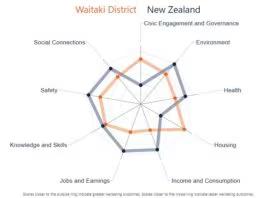Wellbeing: understanding local progress
All eyes are on wellbeing this week, as Finance Minister Grant Robertson unveils the world’s first wellbeing budget. But the Government has been quiet as to wellbeing differs across New Zealand. At Infometrics we thought this was a massive gap that needed to be filled, so we developed a Regional Wellbeing Framework. This article outlines introduces our Regional Wellbeing Framework and provides a teaser to our forthcoming regional wellbeing report that will be released on 11 June.
Introducing the Infometrics Regional Wellbeing Framework
Far from a new concept, wellbeing is at the heart of the outcomes that communities’ value most, rather than just GDP or employment. Measuring local progress also becomes more and more important with the reintroduction of social, economic, environmental, and cultural wellbeing in the Local Government Act.
Two weeks ago, we launched the Infometrics Regional Wellbeing Framework. The Framework provides a local view of how wellbeing outcomes occur, across 30 indicators listed under nine domains of wellbeing – all at a territorial authority level (see Figure 1).
Figure 1

The Regional Wellbeing Framework allows us to reliably assess and consistently measure wellbeing across all 66 of New Zealand’s mainland territorial authorities and 16 regions areas. The Framework also presents the information in an easily accessible format, designed to allow users to understand how wellbeing in a local area compares with elsewhere in New Zealand.
Wellbeing indicators are not new for us, having used a range of wellbeing indicators to develop the Prosperity Index for Auckland local board areas in 2018. We realise that a robust local assessment of progress is important, and that measuring wellbeing outcomes consistently across New Zealand allows for decision makers to understand what areas are doing better or worse.
Time for local government to focus on wellbeing
Wellbeing is an important concept for both central and local government to grapple with, as a focus shifts away from GDP as the only way to measure progress. Reinforcing this point, earlier in May the purpose of local government in New Zealand was changed to reinstate social, economic, environmental, and cultural wellbeing in the Local Government Act as aspects for local government to consider.
However, the Act doesn’t spell out what wellbeing means. Without a clear definition, different organisations, different areas, and different people will come up with a different way of interpreting and understanding wellbeing, which muddied the water and makes a robust and consistent assessment of wellbeing across New Zealand difficult. Instead, Infometrics’ Regional Wellbeing Framework sets out a consistent wellbeing assessment across the country, providing an apples-with-apples comparison of how different areas are going, and helping to identify the areas of relative success and concern.
Government funding applications are likely to change to include a wellbeing emphasis, and annual and long term plans will need to demonstrate how each local council is looking to cement and improve the wellbeing in their local area.
It will become increasingly important for local councils to have an objective, and comparable, assessment of wellbeing to determine what local government, businesses, and others are already doing to improve. This stocktake of current actions will also identify where gaps may exist and highlights how to begin addressing these gaps.
Local problems, local solutions
Different areas have different problems to address, and our Regional Wellbeing Framework has provided the basis for many local authorities to talk about local wellbeing and how it influences local planning and decision making.
There shouldn’t be a one-size-fits-all approach to wellbeing in New Zealand. Different communities face different problems: crime rates in Ōpōtiki (7,431 crimes per 100,000 people) are completely different to crime rates in Selwyn (812 crimes per 100,000 people), and this difference exists across the country and across different domains of wellbeing (see Graph 1).
Graph 1
Understanding local differences in wellbeing across the country is important to how communities, local decision makers, and central government, work to address problems. Without the right insights, we’re not only unable to identify what areas need what interventions, but we’re also blind to the successes of some areas, and how their efforts can be recast and replicated elsewhere in the country.
An important first step when investigating wellbeing locally is to start with a conversation about the current state of play: how is the local area going, and where is it comparatively better or worse than elsewhere in New Zealand?
Hear more about wellbeing in your local area
Understanding wellbeing will only drive local change if the wider community have the opportunity to understand how their local area operates, and feeds into designing changes that will make a difference to peoples’ lives.
On 11 June, Infometrics is launching a public report about regional wellbeing. This coincides with an Infometrics presentation about regional wellbeing at the Measuring Wellbeing event, hosted by the Wellington Chamber of Commerce.
You can learn more about the Regional Wellbeing Framework, and contact Infometrics about a presentation about wellbeing in your local area, by heading to https://www.infometrics.co.nz/regional-wellbeing-framework/






















